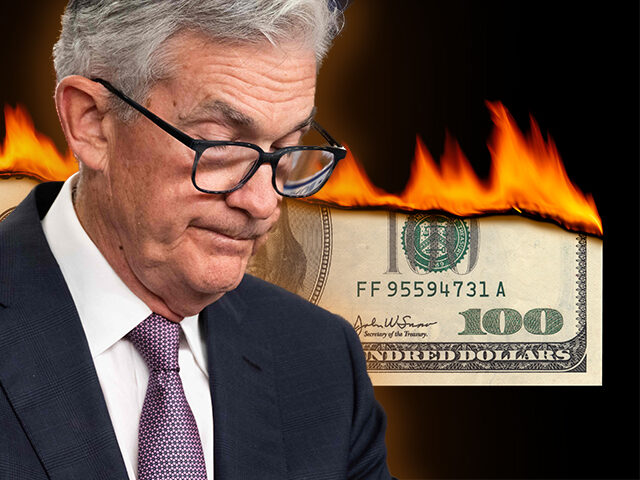The GDP Report Snuffs Out the Dream of a Soft Landing
The pace of economic growth in the first three months of the year was far more sluggish than anyone expected—and inflation was much higher.
The report suggests that the soft-landing scenario—solid growth and steadily falling inflation—is dead. We’re now looking at a no-landing or possibly even a hard landing.
Gross domestic product (GDP), the government’s official scorecard for the economy, grew at a paltry 1.6 percent annual pace in the first quarter. That’s a big slowdown from the 3.4 percent pace in the fourth quarter of last year and a reminder that the pace of economic growth can turn suddenly and unexpectedly.
The consensus forecast was for a 2.5 percent pace of growth—with many on Wall Street wondering if that was going to turn out to be too low. The Atlanta Fed’s GDPNow ended last week at 2.9 percent and registered 2.7 percent on the eve Thursday’s release. The Philadelphia Fed’s survey of professional forecasters had the economy growing at a 2.1 percent rate.
To get a sense of how far off the projections were, we like to look at the range of forecasts in the Econoday survey. The lowest of these was 1.7 percent, a tick higher than the result. In other words, none of the professional forecasters saw the 1.6 percent first quarter pace of growth coming.
By subscribing, you agree to our terms of use & privacy policy. You will receive email marketing messages from Breitbart News Network to the email you provide. You may unsubscribe at any time.
Bad News Is Bad News Again
In recent months, the pattern for markets has been bad news for the economy equaling good news for markets. The logic has been that signs of weakness for the economy could pull forward interest rate cuts or increase the pace of cuts once they get started. On Thursday, however, bad news for the economy was also bad news for the stock market.
One reason for that was that the main drags on GDP were the volatile categories of trade and inventories. Export growth was weak, and import growth (which is a subtraction from the calculation of GDP) was strong. Exports rose by a mere 0.9 percent in the quarter, despite some signs of economic recovery around the globe. It’s a reminder that while it is good that the U.S. economy has bounced back better from the pandemic than almost anywhere else, weakness abroad can weigh on our growth.
Export growth was split evenly between goods—which rose 0.9 percent—and services—up 1.0 percent. It’s very likely that the strength of the dollar against global currencies was part of the problem here, putting U.S. goods and services out of reach for foreign consumers. Global geopolitical turmoil may also have been a drag on export demand. Finally, the Biden administration’s foot-dragging on enhancing the energy exporting capabilities of the U.S. are likely starting to bite—and will weigh on growth for years to come unless November brings a change in control of the executive branch.
Inventories grew by just $35.4 billion in the January through March period, much less than expected. This shortfall shaved 0.35 percent off GDP for the quarter.
Wall Street was willing to look past the weak trade and inventory numbers because these are “non-inertial items,” as Harvard’s Jason Furman put it in a post on X Thursday. Outside of major economic downturns, large swings in inventories tend to reverse in subsequent quarters. Exports do not correlate with shifts in the domestic economy and so should not be taken as predictive of growth in the rest of the year.
Underlying Demand Still Looks Solid
There were signs of underlying strength in the GDP report. Starting with trade, imports were up a sharp 7.2 percent, indicating a high level of domestic demand. Final sales to private domestic purchasers—the best proxy for how the real economy is fairing—grew at a robust 3.1 percent pace. That’s just below the 3.4 percent pace in the prior quarter and above the 3.0 percent growth in the third quarter of last year.
Personal consumption expenditures came in at a 2.5 percent, a still healthy (even if slightly weaker than expected) rate of growth. Spending on goods contracted 0.4 percent, principally on weakness in durable goods, the first contraction since the third quarter of 2021. Softness in auto sales were a big drag here. This may also be a sign of consumer exhaustion with inflation and the weight of higher gasoline prices pushing off other spending.
There was also likely some residual seasonality at play here. Recall that retail sales were weak in January. What’s more, last year’s autoworker strikes left some dealers short of inventory for much of the first quarter. Expectations for interest rate cuts in the first half of this year (which have now evaporated) may have incentivized some consumers to delay purchases until they could get better financing terms.
Spending on services rose by the most since the third quarter of 2021, boosted by health care (everyone loading up on those weight-loss drugs) and financial services (a booming market leading to higher commissions). This was the third consecutive quarter of rising services outlays.
Fixed investment jumped 5.2 percent, good enough to add nine-tenths of a percentage point to overall growth. This was driven by a 13.9 percent surge in residential investment. Housing investment has now expanded for three straight quarters, a sign of robust demand but also limited supply in the existing house market.
Nonresidential investment increased by 2.9 percent despite a decline in business structure investment. This decline in structure investment reflects the fact that subsidies from the federal government pulled forward spending in prior quarters. In the coming quarters, this is likely to remain weak absent a renewed round of government largesse.
Despite the decline in nonresidential structure investment, other business investment was solid. Equipment spending rose 2.1 percent, and intellectual property investment jumped 5.4 percent (probably an AI bounce).
Inflation Still Blazing Hot
The biggest surprise in the report was the strength of personal consumption expenditure (PCE) inflation. This is something that analysts should have been able to nail down pretty well because we already have the reports for the January and February PCE price indexes, as well as the March consumer price index and producer price index. The consensus forecast for core PCE inflation was around a 3.4 percent annualized rate. The Philly Fed’s survey of professional forecasters, which is quite dated at this point, had headline PCE rising 1.9 percent and core up 2.1 percent.
Instead, the government said that PCE inflation came in at 3.4 percent and core came in at 3.7 percent. This could indicate that there will be significant upside revisions to the January and February figures in tomorrow’s March PCE report or that the March report is substantially hotter than the corresponding parts of the CPI and PPI reports suggested. In either case, the bigger than expected number is likely to push off any Fed cuts until next year at the earliest—and raise the odds of a Fed hike.
The worst-case scenario would be growth remaining sluggish or even turning negative while inflation remains too hot for the Fed to cut. This report raises a risk of that, but the underlying domestic demand figures suggest that should not be the base case. The economy is still growing, and inflation is remaining stubborn.
In other words, there’s no landing in sight.



COMMENTS
Please let us know if you're having issues with commenting.